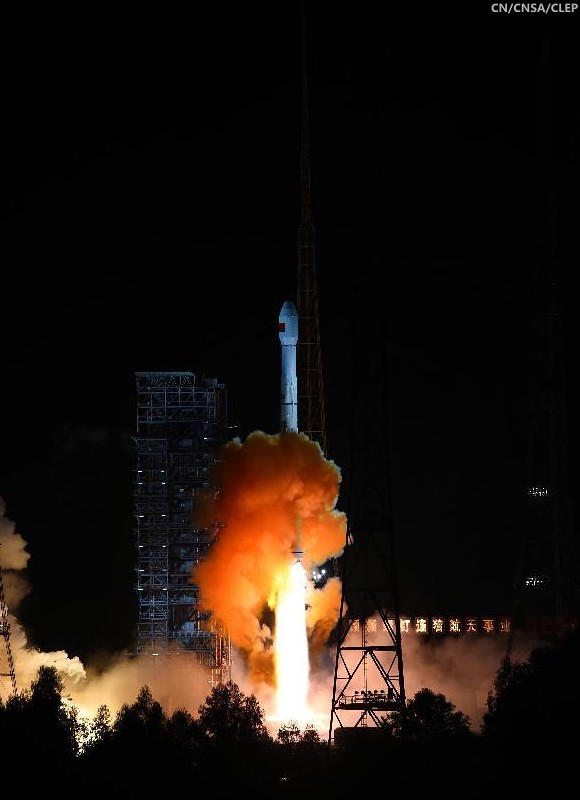 |
Test module launch preparations [CNSA/CLEP].
|
XICHANG, Sichuan, Oct. 24 (Xinhua) -- China launched an unmanned spacecraft early Friday to test technologies to be used in the Chang'e-5, a future probe that will conduct the country's first moon mission with a return to Earth.
The lunar orbiter was launched atop an advanced Long March-3C rocket from the Xichang Satellite Launch Center in southwest China's Sichuan Province.
The test spacecraft separated from its carrier rocket and entered the expected the orbit shortly after the liftoff, according to the State Administration of Science, Technology and Industry for National Defense.
The whole mission will take about eight days. Developed by China Aerospace Science and Technology Corporation, the spacecraft will fly around the moon for half a circle and return to Earth.
On its return, the test spacecraft will approach the terrestrial atmosphere at a velocity of nearly 11.2 kilometers per second and rebound to slow down before re-entering the atmosphere. It will land in north China's Inner Mongolia Autonomous Region.
The mission is to obtain experimental data and validate re-entry technologies such as guidance, navigation and control, heat shield and trajectory design for a future touch-down on the moon by Chang'e-5, which is expected to be sent to the moon, collect samples and return to Earth in 2017.
It is the first time China has conducted a test involving a half-orbiter around the moon at a height of 380,000 kilometers before having the spacecraft return to Earth.
The test orbiter is a precursor to the last phase of a three-step moon probe project, a lunar sample return mission.
China carried out Chang'e-1 and Chang'e-2 missions in 2007 and 2010, respectively, capping the orbital phase.
The ongoing second phase saw Chang'e-3 with the country's first moon rover Yutu onboard succeed in soft landing on the moon in December 2013. Chang'e-4 is the backup probe of Chang'e-3 and will help pave the way for future probes.
Related Posts:
Geologic characteristics: Chang'E-3 exploration region (January 31, 2014)
ESA on Yutu, as controllers wait for sunrise, February 9 (January 31, 2014)
Problem with solar-powered Yutu rover before nightfall (January 25, 2014)
Chang'e begins long-term science mission (January 18, 2014)
Preliminary Science Results from Chang'e-3 (January 16, 2014)
Chang'e-3 and Yutu survive first lunar night (January 14, 2014)
Chang'e-3 APXS delivers its first surface analysis (January 1, 2014)
Chang'e-3 lander and Yutu rover from LRO (December 31, 2013)
6 of 8 Chang'e-3 science instruments now active (December 18, 2013)
LRO: Finding Chang'e-3 (December 15, 2013)
China's Jade Rabbit, it's time in the Sun (December 15, 2013)
Chang'e-3 Landing Site in Mare Imbrium (December 15, 2013)
Jade Rabbit successfully deployed to the lunar surface (December 14, 2013)
It's not bragging if you do it (December 9, 2013)
"Lunar Aspirations" - Beijing Review (December 9, 2013)
Chang'e-3 safely inserted into lunar orbit (December 6, 2013)
CCTV: Chang'e-3, launch past TLO to Earthview (December 2, 2013)
Chang'e-3 launched from Xichang (December 1, 2013)
Chang'e-3 launch window opens 1 December 1730 UT (November 29, 2013)
Helping China to the Moon, ESA (November 29, 2013)
Chang'e-3 and LADEE: The Role of Serendipity (October 31, 2013)
Outstanding animation celebrates China's Chang'e-3 (October 29, 2013)
LROC updates image tally of human artifacts on the Moon (September 25, 2013)
Chang'e-3: China's rover mission (May 4, 2013)
China's grand plan for lunar exploration (October 11, 2012)
ILOA to study deep space from Chang'e-3 (September 11, 2012)
China's Long March to the Moon (January 14, 2012)
China plans lunar research base (May 11, 2011)
PRC continues methodical program (March 8, 2011)
Chang'e-2 arrives in mission orbit (October 9, 2010)
Dispatch from Chang'e-2: Sinus Iridum (October 4, 2010)
Chang'e-2 takes direct approach (October 1, 2010)
Chang'e-2 sets stage for future lunar missions (September 3, 2010)
Chang'e-1 research reported published (July 22, 2010)


No comments:
Post a Comment